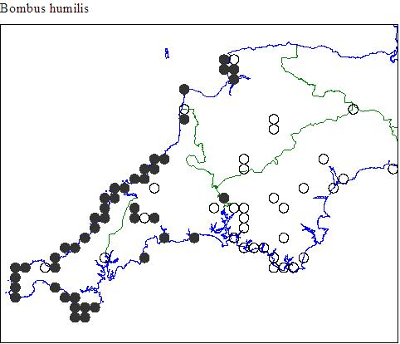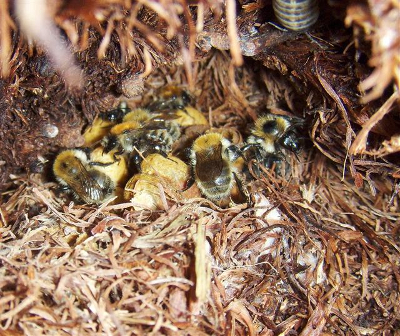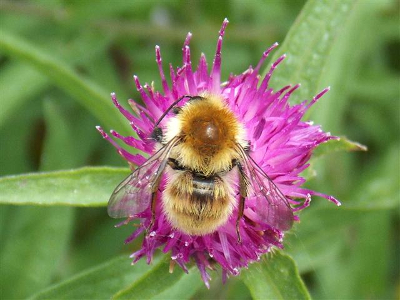

B.humilis is locally common on the North coast of Cornwall and scattered locations on the south coast. Records point to some decline. The species is very similar to B.muscorum and on many sites in Cornwall both species fly together. There is a degree of unreliability in records for both species as a result of misidentification.
B.humilis has greatly declined in Devon, The only strong Devon site for B.humilis (and B.muscorum ) from my experience is the Braunton Burrows (SS4533). Although there are a few recent records elsewhere of B.humilis on the North Devon coast. In Devon the species appears to be no longer present on the South coast or inland. M.Spooner (1985) quotes R.Perkins Common generally distributed in Devon. On East Dartmoor about 8-900ft abundant on wood sage R.C.L.P. 1913)
Much declined in the U.K. strongest populations found in South Wales, Salisbury plain Eastern Thames estuary and some other locations on the South coast.
Fairly late species although in Cornwall can occur reasonably early with Queens in mid April. With peak numbers between Late June to Late August although some numbers can be seen into September. The populations in Cornwall appear to peak earlier than other populations such as Kent (Per, Comm. M. Edwards).
Long tongued and surface nesting. Colony size small. nests generally on the surface of the ground in tall grassland., with nests woven from grass and mosses. In 2008 I found a nest on the slopes of a Cornish hedge slightly underground in thrift tussocks, It seems likely that the species nests within the cliffs themselves.
Found on high quality grassland, dune and heathland mosaics. Probably has a short foraging range and relys on very high quality habitats fairly close to the nest. The nest I found bore this out as was surrounded by a rich patch of Red clover Trifolium pratense.
The species is associated in Cornwall with Kidney vetch Anthylis vulneraria, which appears to be the most important forage for queens. A variety of other forage is used by workers inc. Red clover Trifolium pratense, Betony Stachys officinalis, Birds-foot trefoil Lotus corniculatus, Knapweed Centaurea nigra and Wild thyme Thymus polytrichus. Can be present on quite narrow linear habitats on the North coast of Cornwall.
The main reason for the species survival in Cornwall appears to be the survival of the extensive area of semi natural area of habitat of the northern cliffs kept from succession to scrub by the exposed climate and cliff soils. This habitat, although in some cases becoming very narrow, forms a long strip of continuous habitat, which fulfils the requirement for the species to have large areas of high quality forage. About 1km.sq. per nest is estimated to be needed (Edwards 2001).
The species in comparison with some of the other rare species has quite long and possibly flexible phenology this may mean the species is better able to exploit the North coast of Cornwall with its erratic climate than species such as B.ruderarius and B.soroeensis. At the Northern edge of its range in Southern England. Research suggests possibility climate change may be benefiting this species to the detrement of B.muscorum (Lee et.al 2009). Warmer seasons may allow the species to colonise more marginal habitats. Malcolm Spooner (Spooner 1985) says about B.humilis “quite general in South west Devon, but mainly in the drier parts and most common in finer years.
The Cornish population of B.humilis is important on a national scale. Although there are more conservation grazing schemes for other spieces, there is no schemes introduced specifically for the species and schemes for high profile species such as the Chough Pyrochorax are likely to bring benefits. Summer grazing should be approached with caution as it may be detrimental for the species by decreasing the sward height too much and reducing summer flowering. Protection and suitable management of coastal flower rich grassland. Introduction of Pollen and nectar margins or clover leys in agricultural landscape within 1km of known colonies. Intensification of any flower rich habitat within 1km of suitable sites (most areas of the North Cornish coast) and under grazing of coastal sites is having a detrimental effect in some areas.
Lee et al, 2008, Hymettus report 2008, Hymettus
Spooner, M.(1985) Unpublished notes, Bumblebees in Devon

Bombus Humilis Map

Humilis Nest Trevose head

Bombus Humilis Male